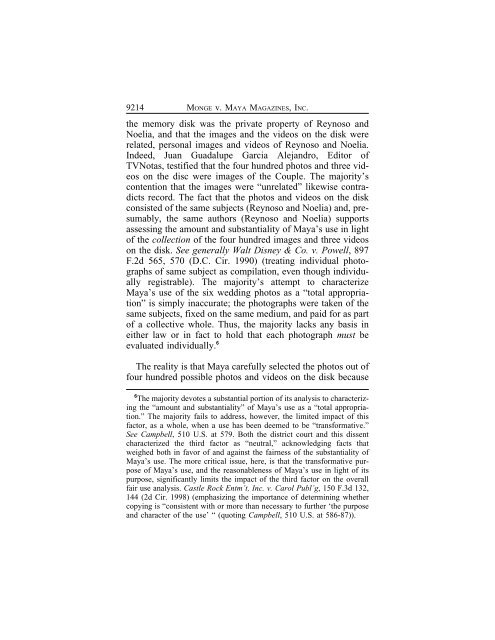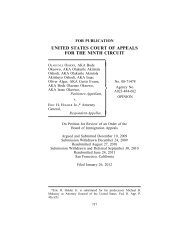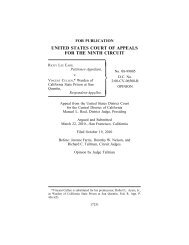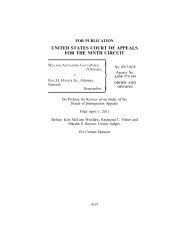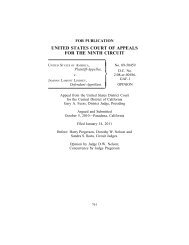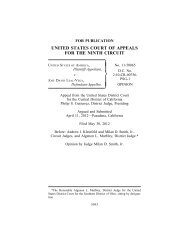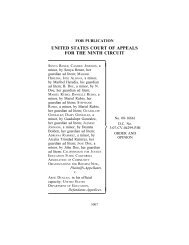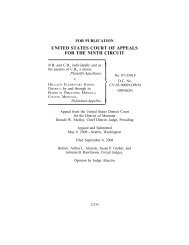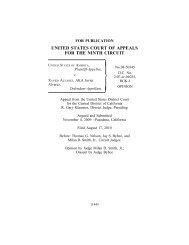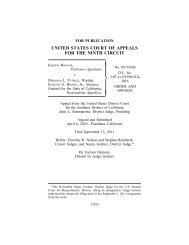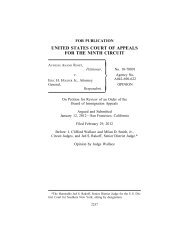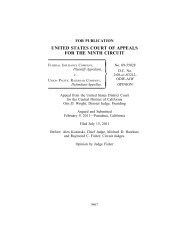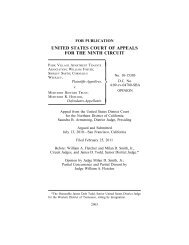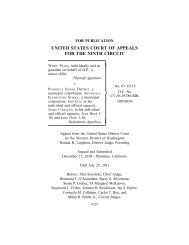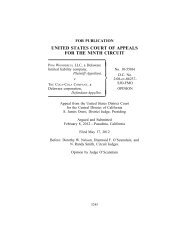NOELIA MONGE V. MAYA MAGAZINES, INC. - Ninth Circuit Court of ...
NOELIA MONGE V. MAYA MAGAZINES, INC. - Ninth Circuit Court of ...
NOELIA MONGE V. MAYA MAGAZINES, INC. - Ninth Circuit Court of ...
You also want an ePaper? Increase the reach of your titles
YUMPU automatically turns print PDFs into web optimized ePapers that Google loves.
9214 <strong>MONGE</strong> v. <strong>MAYA</strong> <strong>MAGAZINES</strong>, <strong>INC</strong>.<br />
the memory disk was the private property <strong>of</strong> Reynoso and<br />
Noelia, and that the images and the videos on the disk were<br />
related, personal images and videos <strong>of</strong> Reynoso and Noelia.<br />
Indeed, Juan Guadalupe Garcia Alejandro, Editor <strong>of</strong><br />
TVNotas, testified that the four hundred photos and three videos<br />
on the disc were images <strong>of</strong> the Couple. The majority’s<br />
contention that the images were “unrelated” likewise contradicts<br />
record. The fact that the photos and videos on the disk<br />
consisted <strong>of</strong> the same subjects (Reynoso and Noelia) and, presumably,<br />
the same authors (Reynoso and Noelia) supports<br />
assessing the amount and substantiality <strong>of</strong> Maya’s use in light<br />
<strong>of</strong> the collection <strong>of</strong> the four hundred images and three videos<br />
on the disk. See generally Walt Disney & Co. v. Powell, 897<br />
F.2d 565, 570 (D.C. Cir. 1990) (treating individual photographs<br />
<strong>of</strong> same subject as compilation, even though individually<br />
registrable). The majority’s attempt to characterize<br />
Maya’s use <strong>of</strong> the six wedding photos as a “total appropriation”<br />
is simply inaccurate; the photographs were taken <strong>of</strong> the<br />
same subjects, fixed on the same medium, and paid for as part<br />
<strong>of</strong> a collective whole. Thus, the majority lacks any basis in<br />
either law or in fact to hold that each photograph must be<br />
evaluated individually. 6<br />
The reality is that Maya carefully selected the photos out <strong>of</strong><br />
four hundred possible photos and videos on the disk because<br />
6 The majority devotes a substantial portion <strong>of</strong> its analysis to characterizing<br />
the “amount and substantiality” <strong>of</strong> Maya’s use as a “total appropriation.”<br />
The majority fails to address, however, the limited impact <strong>of</strong> this<br />
factor, as a whole, when a use has been deemed to be “transformative.”<br />
See Campbell, 510 U.S. at 579. Both the district court and this dissent<br />
characterized the third factor as “neutral,” acknowledging facts that<br />
weighed both in favor <strong>of</strong> and against the fairness <strong>of</strong> the substantiality <strong>of</strong><br />
Maya’s use. The more critical issue, here, is that the transformative purpose<br />
<strong>of</strong> Maya’s use, and the reasonableness <strong>of</strong> Maya’s use in light <strong>of</strong> its<br />
purpose, significantly limits the impact <strong>of</strong> the third factor on the overall<br />
fair use analysis. Castle Rock Entm’t, Inc. v. Carol Publ’g, 150 F.3d 132,<br />
144 (2d Cir. 1998) (emphasizing the importance <strong>of</strong> determining whether<br />
copying is “consistent with or more than necessary to further ‘the purpose<br />
and character <strong>of</strong> the use’ “ (quoting Campbell, 510 U.S. at 586-87)).


